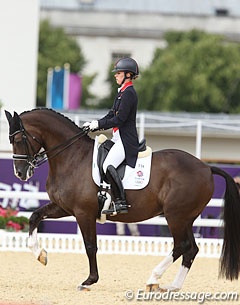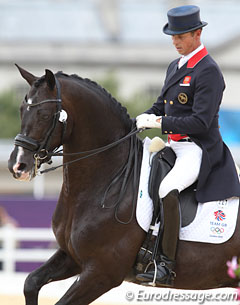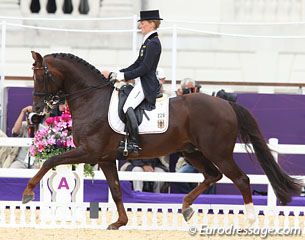
The best way to encourage lightness, empathy, and compassion in training, is to reward those that employ it in their everyday work. The tricky part lies in detecting and indeed finding the margin in a competitive dressage arena, to place these dressage riders above those that use harmful or forceful methods.
So how does a top judge detect lightness in training in elite level dressage? And how do they then reward these combinations, effectively placing them above other perhaps more powerful or flamboyant horses, to give riders and trainers the incentive to train in the right way?
"Every top athlete, be it man or horse, needs a certain amount of positive tension to compete at the highest level," says O-Judge Stephen Clarke. “However, there is a world of difference between healthy ‘positive tension’ and destructive physical stress and mental anxiety.”
Stephen Clarke mentions that the most obvious sign of stress is when the paces become jerky or artificial; often the trot appears hectic or staccato, losing its natural fluidity and cadence. Sometimes the walk can deteriorate to the point where the horse is unable to relax into a clear and regular four beat, or even may jog or show ‘piaffe like’ steps throughout. The canter again may lose its clear three time beat and either ‘scratches’ along the ground with barely a moment of suspension, or if the back is so tight, may appear to show climbing, laboured steps with very limited action of the hind legs (“The paralysing effect of resistance” Podhajsky) Also the horse may, through anxiety, be unable to maintain immobility at the halt, or even halt at all.”
Danish O-judge, Leif Törnblad, acknowledges that we cannot know what goes on behind the scenes, but a judge must learn to pick up on those subtle signs of stress in the dressage horse.
"The usual signs of stress are open mouth and resistance on the bit, grinding teeth, tongue hanging out, sweating horses, swishing tails. All that is well known to everybody, but as a judge you will have to take these signs as a signal of something else."
However, Leif says this is very complex, as for example some horses may grind their teeth, but this isn't always a direct sign of stress. "A horse might grind his teeth without being in stress, as they may be just eager and excited!"
The important thing however, as a judge, is to not only detect the sign of stress, but examine the context and attempt to establish a more concrete verdict as to what may be causing such signs to appear.
"When I see the obvious sign I try to detect other more profound and serious signals,” says Leif. “Is the horse forced into a too rigid frame between hands – seat and legs? Is the back swinging or can you see tension in the top line? Is the horse willing and moving forward easily?"
 Mexican O-Judge, Maribel Alonso, finds that tension is most commonly detected "when the purity of the paces is altered. The horse should look relaxed and comfortable with his rider, moving with ease and regularity. If a horse is stressed or tense; the connection with the mouth is no longer soft and still, the contact becomes unsteady, tongue pulled up, or tongue out, the neck becomes too short, the full expression of the horse loses harmony and confidence, the horse will hollow in the back etc."
Mexican O-Judge, Maribel Alonso, finds that tension is most commonly detected "when the purity of the paces is altered. The horse should look relaxed and comfortable with his rider, moving with ease and regularity. If a horse is stressed or tense; the connection with the mouth is no longer soft and still, the contact becomes unsteady, tongue pulled up, or tongue out, the neck becomes too short, the full expression of the horse loses harmony and confidence, the horse will hollow in the back etc."
Certain that incorrect training will manifest itself in all three gaits, the judges all agree that the tension can become even more obvious in the walk. "Especially in the collected walk," says Maribel
Leif adds that "the walk will become very tense and short or even without clear rhythm, and says the canter can also become hectic and with a stiff top line. "Flying changes are thus made very short, and again hectic, if the horse is under pressure."
Stephen stresses that “the main objective of correct dressage is to establish the horse’s natural paces and enhance them through systematic and gymnastic training Poor training will manifest itself in the deterioration of all three paces”.
Leif knows, however, that it is unavoidable during some periods of training, that a horse may become a bit stressed, but a good rider will be able to quickly ease the tension, and calm the horse in the appropriate way.
"When learning new movements, for example, he may become stressed, but if the rider takes it the easy way and does not repeat difficult (for the horse) movements during the learning process, this sort of stress will be a minor problem. Unfortunately you very often see riders that repeat the movements that are difficult for the horse many times in the warming up, and even around the arena. The only outcome of that is that the horse performs worse in the arena."
There are a number of ways harmful and unjust training can present itself, but equally obvious are the many signals of light, effective, well balanced training techniques.
"A well trained talented horse moves easily forward with attentive ears and a closed mouth and can execute the different movements with ease."
According to Maribel "lightness can be detected when the horse has been correctly trained showing elasticity and flexibility throughout its performance, being smooth and fluent and achieving perfect balance. We can observe it in a well performed transition free of tension or resistance".
“The horse that presents such a high degree of lightness and self carriage showing a steady and flawless contact are unmistakably the best trained ones and therefore they are the ones awarded the highest scores. I am sure that those high scores as well as the incredible feeling such trained horse provides become the incentive to improve the way of training."
The outcome of correct training, Stephen says that lightness and self-carriage will only be achieved "when all of the criteria of the Scale of Training have been met".
 "Only then, will the horse have the balance and the elasticity in his paces to show a lightness of footfall that, to the onlooker, appears to be hardly touching the ground," says Clarke. "Only when the training is fully developed and the horse is truly light on the ground and in a genuine self carriage, will he be able to demonstrate absolute harmony and expression throughout all of the exercises. We have been lucky enough to witness this at the recent London Olympic Games, which surely in itself will be an incentive for riders to train in the right way if they want the highest points."
"Only then, will the horse have the balance and the elasticity in his paces to show a lightness of footfall that, to the onlooker, appears to be hardly touching the ground," says Clarke. "Only when the training is fully developed and the horse is truly light on the ground and in a genuine self carriage, will he be able to demonstrate absolute harmony and expression throughout all of the exercises. We have been lucky enough to witness this at the recent London Olympic Games, which surely in itself will be an incentive for riders to train in the right way if they want the highest points."
With the power and brilliance of the horses being produced today, I wondered if the training might be being compromised as a result of all this power, and that perhaps it needed to adjust or slow, in order not to restrict what the breeding world is producing?
"I think the breeding is moving in the right direction and that the riders have become better and more clever when they select a good horse for dressage. The present Olympic gold winner, Valegro, is a good example of a fantastic athlete, even if he is not the most beautiful horse when he is standing still.” says Leif . “A well deserved victory for Britain and the horse, Valegro's training also appears to have been undertaken with a lot of feeling and in a good manner!"
"In my opinion breeding has changed and is constantly developing in a very positive way," says Clarke. "Compared to earlier times, riders of today have already so much more access to horses with beautiful conformation and inherent gymnastic ability. I believe this is one of the main reasons that we now have so many combinations vying for the top spots, which makes our sport all the more exciting. I am convinced that the breeding has changed for the better. In my opinion it has improved so much that is has become a challenge to trainers, riders and judges. Riders and trainers have to be even more aware of the importance of correct basic training in order to preserve this movement and expression. The last Olympic Games has been a clear example of how many good riders and trainers there are as we had the opportunity to witness some performances that were an inspiration for the upcoming GP elite riders of the world."
The judges make an excellent point and really it is up to the entire dressage community -- trainers, riders, and judges -- to meet the challenge, take time to establish the horses confidence, and accommodate the horses natural talent and expression into our everyday work.
While judges may never know what truly goes on behind the scenes, it is with the desire to reward true lightness and commend the happiness of the horse, that a brighter dressage future will be ensured for our equine partners . And in order to promote correct education and training we must first award those at the highest level, acknowledging them as the true ambassadors of our sport.
And it seems the world's best is on top of it!
by Sarah Warne
Related Links
Olympic Pulse: What Will London Be About?
Diversity and Lightness, Essential for the Development of the Horse
Q & A Session on the State of Dressage with I-Judge Angelika Fromming
Horse-friendly Dressage Training with Klimke and Thomsen: Desensitise and Motivate
ISES Suggest to Empower FEI Stewards to Control Tightness of Noseband